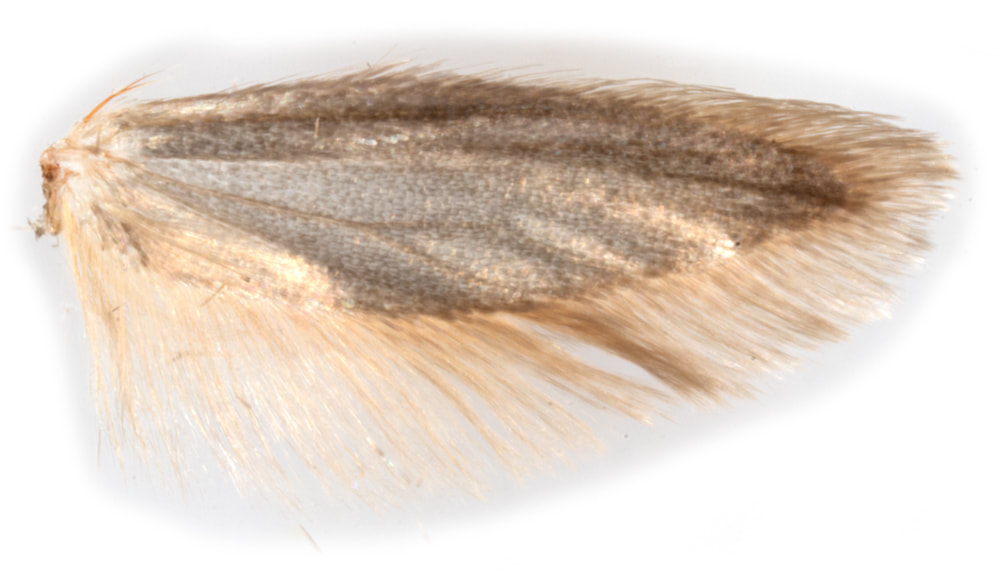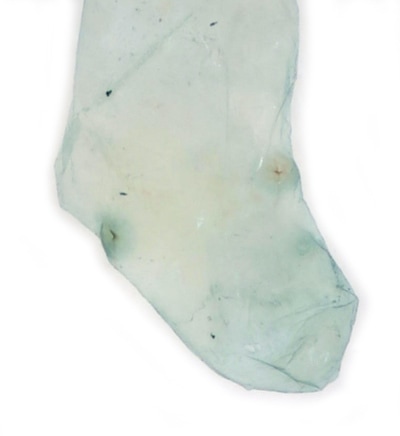12.027 Tinea pellionella (Case-bearing Clothes Moth)
ws: 9-16mm; Jun-Oct; Common in houses, barns, warehouses, granaries and bird nests throughout UK.
ID; 3 British species of Tinea have a poorly marked fuscous ochreous forewing with at least the 2nd (apical) discal stigma defined and head dull ferruginous. These require genital dissection for confirmed ID (figured on pp 200-201 of MBGBI2).
T.pellioinella (ws9-16mm) is the commonest British Clothes Moth and all specimens I have examined so far have proven to be this species.
T.dubiella (ws9-15mm) has a darker grey hindwing than the other 2 species in this group and the forewing is sprinkled with ochreous scales.
T.flavescentella (ws8-17mm) is local, uncommon and declining, it tends to have a paler whitish-ochreous forewing than the other 2 species in this group.
Niditinea species are keyed (MBGBI2) as separable from Tinea species by having strong dark irroration at least in the apical area of the forewing and a strongly chequered costal fringe - however I have not been convinced by either of these features in images available on-line.
Niditinea fuscella looks very similar to the Tinea pellionella group and I suspect is best separated by genital examination.
T.pellioinella (ws9-16mm) is the commonest British Clothes Moth and all specimens I have examined so far have proven to be this species.
T.dubiella (ws9-15mm) has a darker grey hindwing than the other 2 species in this group and the forewing is sprinkled with ochreous scales.
T.flavescentella (ws8-17mm) is local, uncommon and declining, it tends to have a paler whitish-ochreous forewing than the other 2 species in this group.
Niditinea species are keyed (MBGBI2) as separable from Tinea species by having strong dark irroration at least in the apical area of the forewing and a strongly chequered costal fringe - however I have not been convinced by either of these features in images available on-line.
Niditinea fuscella looks very similar to the Tinea pellionella group and I suspect is best separated by genital examination.
|
§1 Westcliff-on-sea, Essex; 30/07/2009; male; fw 6.0mm
§2 Westcliff-on-sea, Essex; 08/07/2008; fw 5.2mm §3 Westcliff-on-sea, Essex; 02/07/2008; fw 4.8mm §4 Westicliff-on-sea, Essex; 24/08/2010 §5 Westcliff-on-sea, Essex; 24/07/2011; male §6 Arne, Dorset; 02/07/2016; female; fw 6.6mm §7 Arne, Dorset; 06/07/2016; female; fw 6.6mm §8 Romansleigh, Devon; 28/06/2016; male; fw 5.7mm All images © Chris Lewis |
§9 Westcliff-on-sea, Essex; 10/08/2020
§10 Westcliff-on-sea, Essex; larva found 16/01/2021, adult emerged 04/03/2021; female; fw 6.5mm §11 Westcliff-on-sea, Essex; 07/06/2022 |
Page published February 2011 (§1-4) | §5 added 27/07/2011 | §6-7 added 11/12/2016 | §8 added 10/04/2016 | §9 added 05/02/2021 |
§10 added 24/03/2021 | §11 added 19/10/2022
§10 added 24/03/2021 | §11 added 19/10/2022





































